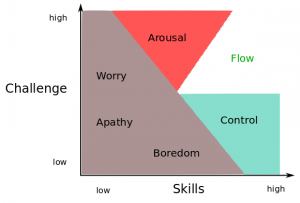Upon writing my current thesis, I discovered the flow-concept of Mihály Csíkszentmihályi, whose name I really can’t pronounce or type without copy and paste, so I will call him Mr. C. for the following. Flow is a state you can reach when there is an equilibrium like state between your skills for a task and the current challenge provided in a task. There are many visualisations of this, but since I made my own, I will just present you that one:

His concept also includes states like relaxation and anxiousness, but in the end, the detail in a visualisation doesn’t really change what the main concept is there.
And we could leave it at explaining the concept in this way, but then there is research in immersion. Immersion is a term that describes the complete involvement in a medially presented environment such as movies or games or audio feature. A good example for mass wide immersive effects in that regard would be for example the audio adaption of ‘War of the Worlds’, that was done by Orson Welles in 1938 and created a brief mass panic because listeners thought they heard real news bulletins. A similar example is the cinematic story of early films that showed train rides. Viewers were expecting the train actually riding towards them, while it was only the representation of a train. And then there are games.
As a game developer you want your game to be immersive out of many reasons. But how to actually achieve this result hasn’t been made clear so far. Nacke and Linley established some parameters to measure flow and then guidelines on how to increase it; however, their approach appears to be rather focused on graphical games. First-Person-Shooters don’t have to rely on visuals, as I learned recently while studying blind players, but visual bias is a general and different problem. Their guidelines include for example, that you shouldn’t use repetitive textures. And boy, it would have been so easy to just abstract that guideline to: have an environment that changes often enough to not be dull, or just _something_ to that effect. Otherwise ten different researchers just create ten different lists of guidelines, which are essentially the same, but are so detailed you can only use it verbatim for a certain set of games or even just a certain game. ¹
tldr: Flow exists. Immersion can be achieved when the players are in a state of flow. How that actually can be done is still mysterious.
¹ So why did they choose this one game btw and not another? ²
² I chose the game I’m focusing on in my thesis without any funding from them and without any other promises of making them look good or something. I am just familiar with the code base, which made it easier for me to work with it.
